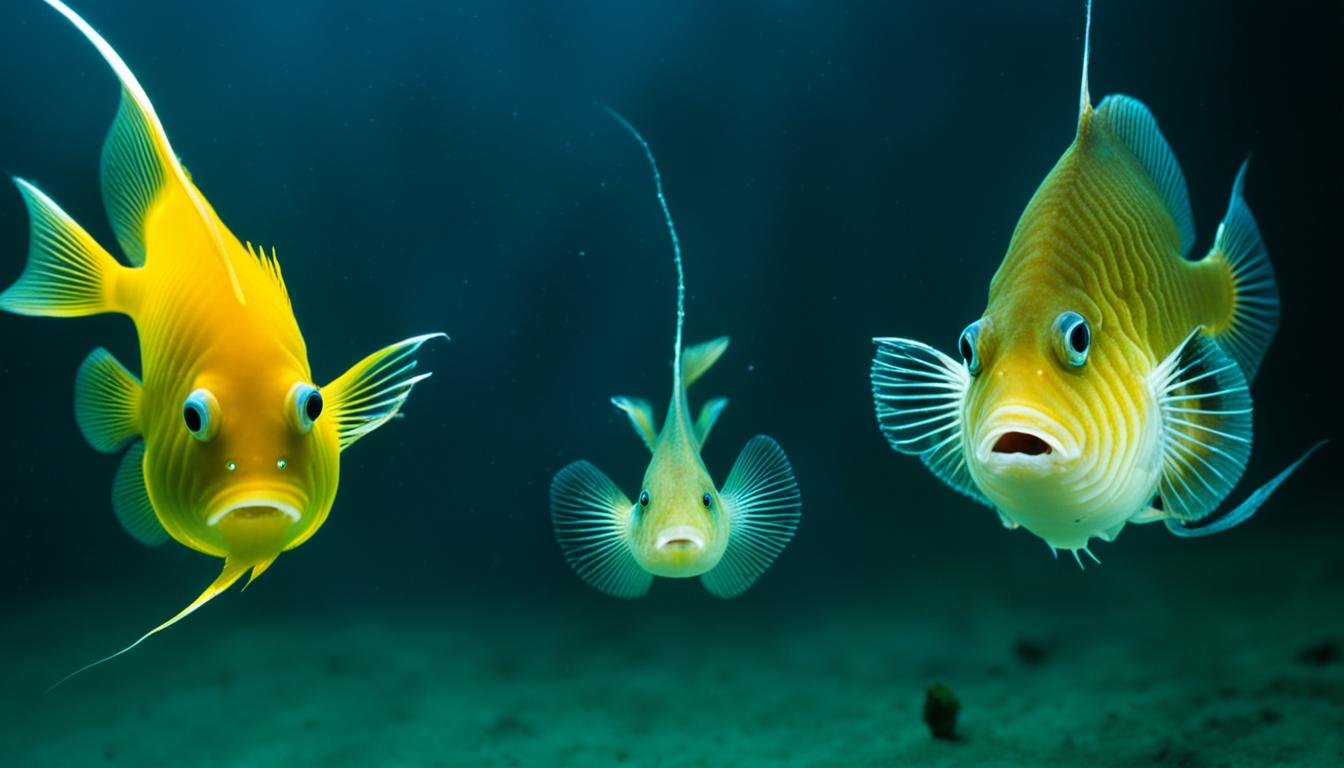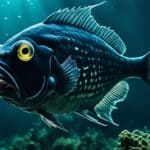The anglerfish show a unique example of how males and females differ. They have extreme differences in size, shape, and color. Females are much bigger than males, often over 60 times larger. This difference sparks curiosity about their biology and roles in nature.
This article will look into the physical traits, mating habits, and reproductive strategies of these fish. It aims to shed light on the anglerfish gender differences.
Understanding Sexual Dimorphism in Anglerfish
Anglerfish show us how sexual dimorphism works in nature. This means males and females look very different, especially in these fish. Both genders are in the same family but have unique traits. These traits help them survive and reproduce.
Overview of Sexual Dimorphism
Anglerfish have big size and shape differences between males and females. Males grow much smaller than females, which is key for their role in making babies. They have special features to find females deep in the ocean where it’s dark.
Their bodies are built for moving fast to reach potential mates in the dark.
The Significance of Size Differences
Size matters in anglerfish for a reason. Big females can lay more eggs, which helps keep the species going. Smaller males attach to these big females during mating. This creates a special bond where males get food and help with making babies.
| Aspect | Male Anglerfish | Female Anglerfish |
|---|---|---|
| Size | Much smaller | Significantly larger |
| Function | Locate and bond with females | Produce and care for eggs |
| Mobility | High | Lower, due to size |
| Reproductive Strategy | Attach to females | Fertility and nurturing |
This shows how each gender has a special role in making babies. It’s amazing how anglerfish have adapted to be so different.
How do male and female anglerfish differ?
The differences between male and female anglerfish show how amazing marine life can be. These anglerfish gender differences highlight the special ways each gender has adapted to live in deep-sea environments. We’ll look at the big size differences and their physical traits.
Size and Weight Disparities
Size is a big difference between male and female anglerfish. Females can be much bigger than males, sometimes over 60 times larger. They also weigh a lot more, often hundreds of thousands of times more than males.
This size difference is crucial for their survival. Bigger females can catch and eat more prey. Smaller males use less energy to find mates in the vast deep sea.
Physical Characteristics
The characteristics of male and female anglerfish go beyond size. Females are stronger and have a special lure that attracts prey in the dark. This lure helps them hunt.
Males have big eyes and large nostrils that help them find female signals. When they attach to a female, males change a lot, becoming sexual parasites. This shows how unique the anglerfish gender differences are.

Characteristics of Male and Female Anglerfish
Looking into male and female anglerfish shows us how different they are. Each has unique traits that help them survive in the deep sea.
Distinct Traits of Female Anglerfish
Females are much bigger than males, reaching up to 3.3 feet long. This size helps them survive in deep waters. They have a special bioluminescent lure to catch prey in the dark.
They also have strong jaws to eat large prey. This lets them be top predators in their world.
Traits Found Only in Male Anglerfish
Males are smaller than females and have special senses. Their big eyes and nostrils help them find females by smelling pheromones. Once a male finds a female, he bites her and stays with her for life.
This shows how different males and females anglerfish are. Males focus on mating and get nutrients from females.
Anglerfish Mating Behaviors
In the deep ocean, anglerfish have fascinating ways of finding each other to mate. The males use special smells to find females. This helps them in the dark sea, making it easier to find a mate.
Male Mating Strategies
When a male finds a female, he bites onto her. Then, their bodies join together. This creates a strong bond that lasts forever. The male gets to be close to the female and help with her eggs.
Female Anglerfish’s Role in Reproduction
The female anglerfish is key to making more fish. She is much bigger and lays thousands of eggs. After joining with a male, he fertilizes her eggs inside her. This shows how important the female is for the survival of the species in the deep sea.
FAQ
How do male and female anglerfish differ?
Male and female anglerfish are quite different in size, with females often being much bigger than males. Females have special features for making babies, while males have better senses to find females.
What is sexual dimorphism in anglerfish?
Sexual dimorphism in anglerfish means big differences between males and females. These differences help them play their roles in making babies.
What are the characteristics of male anglerfish?
Male anglerfish are much smaller than females. They have big eyes and nostrils to smell out females. When they mate, they attach to females and share nutrients to help the babies grow.
Why are female anglerfish larger than males?
Female anglerfish are bigger because they need to make lots of eggs. Being big helps them catch more food, which they need for making babies.
How do anglerfish reproduce?
Anglerfish reproduce in a special way. Males attach to females and help fertilize her eggs inside. This way, they make sure the next generation will survive in the deep sea.
What distinct traits do female anglerfish have?
Female anglerfish have a special light on their head to catch food and big jaws to eat large prey. These traits help them survive in the deep sea.
What are the male mating strategies of anglerfish?
Male anglerfish use smells to find females from far away. When they find one, they bite and stick to her. This way, they get a chance to make babies with her.
What is the role of female anglerfish in the reproduction process?
Females are key in making babies. They lay thousands of eggs because they are big. They take care of the babies by fertilizing them inside themselves.







